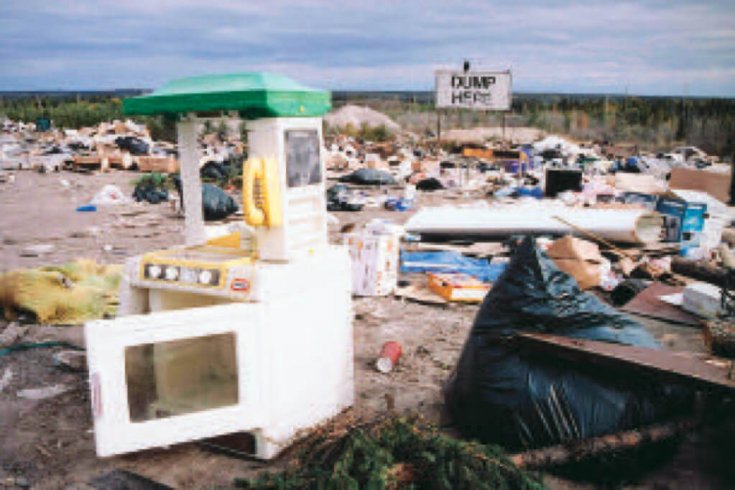yellowknife—It’s the last stop on the highway that cuts through the taiga landscape and whaleback granite surrounding Great Slave Lake. It’s a terminal city, and it’s remote—a fifteen-hour drive north from Edmonton if you take it in a straight shot and the weather’s on your side.
It’s hard to get here by road and it’s expensive to fly. The story is no different for freight. So, most of what comes to Yellowknife stays in Yellowknife, and, sooner or later, it ends up at the local dump, which festers just a couple minutes drive from downtown. Stereos, records, TV sets, cars, ancient sets of encyclopedia, furniture, building materials, rotting food, even jewelry and cash—it’s all here amid the spent diapers, decaying insulation, and, occasionally, caribou or muskox parts.
If you see something you like, you can haul it away for free.
Which is exactly what Yellowknifers do, in surprising numbers. On a heavy summer weekend, as many as 900 vehicles can pass through the dump gates. About 18,000 people live in Yellowknife, which suggests as much as five percent of the population may forsake an afternoon at the municipal pool, the library, or park to go out and sift through the dank spread of sub-Arctic refuse.
A few dozen people do it for money. The best earn thousands of dollars collecting scrap metal and shipping it south. One lucky scavenger may have stumbled on a bonanza a few weeks ago when, according to a witness, the military dropped off a huge pile of old aluminum tent poles. Others pick up radios, vacuum tubes, toys, and board games, which they sell to collectors over Internet sites such as eBay. For most, though, a visit to the dump is a chance to cruise for useful things, gossip with neighbours, and, most important, partake of a deep and proud local tradition.
Yellowknifers are among the last municipal taxpayers in North America permitted unfettered access to their neighbour’s trash. That status spooks city officials, who are paid to think about the safety of people crawling around landfills. A number of years ago, they evicted the otherwise homeless residents of a small shantytown that had sprung up near the trash heaps. The fire department then burned the shacks, which the residents had built from handy scraps. Yellowknifers bristled and called the move a hard-hearted assault on the town’s freewheeling, live-and-let-live character.
The heat was on city administrators again last summer when Katherine Silcock, environment coordinator for
the public works department, inadvertently suggested at a public meeting on solid-waste management that the city could limit public access to the dump. Quoting her comments selectively, the Yellowknifer, the local, twice-weekly newspaper, pilloried her in its next edition.
Yellowknifers—already angry at the city over a bylaw that banned downtown hotdog vendors—erupted. Silcock became a pariah, ostracized at parties and harangued in public. “Every time I walked down the street, someone would come up to me and say ‘Don’t shut down the landfill,’” she says, recalling her summer of discontent.
Yet the city had reason to worry about public safety, as well as the possibility of a lawsuit arising from an accident at the dump. Silcock herself had recently pulled a wandering kid out of the path of a loader as it backed up through the narrow lanes of garbage. Eventually, the municipal council stepped in. Its members claimed that blocking access to the dump had never been on the agenda, although they agreed that measures should be taken to protect public safety. Some also noted that no councillor would want to head into the fall election as the candidate who helped shut down the fun.
Why did the mere suggestion of limiting access to the dump raise such as fuss? “The tradition goes back to early days,” says Walt Humphries, a prospector and artist who’s made weekly visits to the dump since moving to Yellowknife thirty years ago. “Everything was boated or planed in, so people salvaged pieces of metal, pieces of wood—anything that was a valuable commodity. It’s carried on since then.”
It was a brilliant, mid-week afternoon, and Humphries was strolling through the dump. About a dozen other people were out rummaging through the day’s pickings.
Some of the city’s safety changes were evident. The dirt paths into the dumping areas have been widened to accommodate traffic. New signs direct visitors through the piles. The improvements are a step back to what it used to look like, remarked Humphries, who has become a kind of curator for the place, thanks in part to his Yellowknifer column “Tales from the Dump.”
But Humphries is more interested in economics than politics or history. “Your standard of living improves when you can find things at the dump,” he said, raising his voice to cut through the screaming of seagulls overhead. “If you find a toaster out here, you’re not going to go buy a toaster. But you are going to spend that money on something else. When I was building a cabin, half the cabin came from the dump—windows, doors, hinges. We found one of the early chainsaws out here, one of the first ones made. That was kind of neat,” he said.
In a recent column, Humphries estimated the dump puts something like half a million dollars into the local economy. “Shopping”—as scavenging is sometimes called in the local argot—also contributes to the culture of the community.
Yellowknife isn’t the frontier mining town it was before 1967, when it became the capital of the Northwest Territories. It’s a modern city, a centre of government, constitutional politics, diamond mining, gem cutting, and transportation into Canada’s arctic. Growth has tamed much of the frontier character, but not the desire to embrace the mythology of frontier life.
As Yellowknife has become more ordinary, the effort to seize on quirky traditions has become more pronounced. The dump is now an occasional tourist attraction. A couple of local filmmakers based a cable-access TV show among the heaps, a program that mixed the charms of Antiques Roadshow with demolition derby. One show featured the fishing columnist for the newspaper casting lines into the greasy piles.
Individual expression reaches its zenith, perhaps, with people like Craig Yeo, who’s decorated most of his home with findings from the dump. A kind of Martha Stewart for trash, Yeo has fashioned a headboard for his bed from abandoned goalie pads. He built a privacy screen from metal bunk beds once used at the local jail. He even hangs stuff on his walls, notably a hand-made diorama of the Last Supper that includes a chorus line of feral Barbies.
Yeo’s aesthethic manifesto is simple enough. “I figured I’d rather have garbage than buy garbage… Even if it’s crap—ugly crap!—it’s still better than the crap that everybody else in the world has got, that doesn’t last and that you have to pay through the nose for.”
The current truce between the public and the city council may not last forever. Yellowknife’s other funky traditions—notably the tumbledown shacks of Old Town and the houseboats on Yellowknife Bay—have from time to time fallen under the gaze of the city’s safety mavens. Projections suggest Yellowknife has a number of boom years ahead. As it grows, conflicts between the needs of the new and the desires of the old will rise again.





